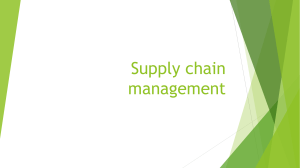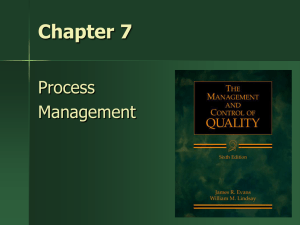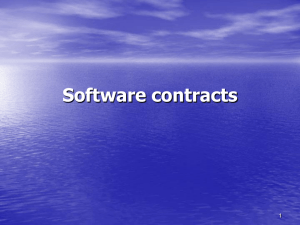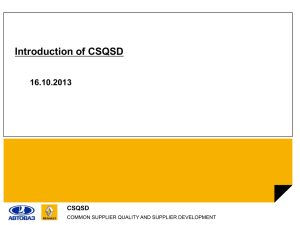Chapter 1
advertisement
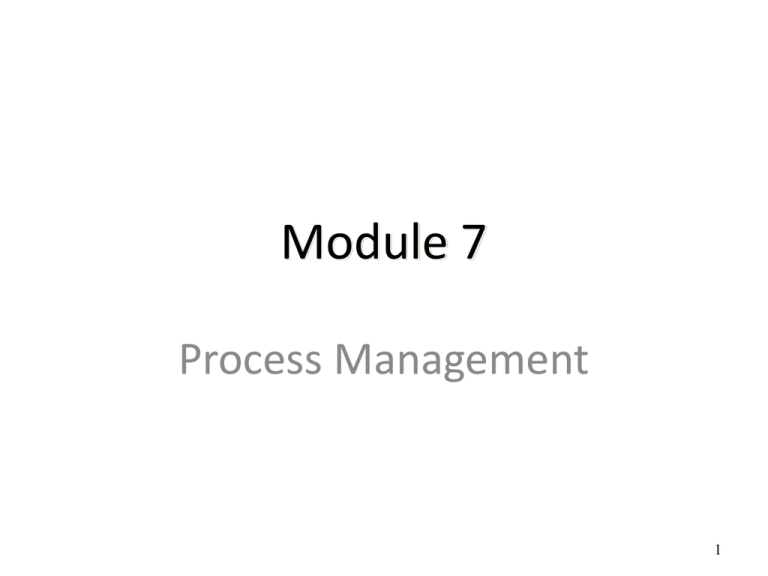
Module 7 Process Management 1 Wisdom from Texas Instruments “Unless you change the process, why would you expect the results to change” 2 Scope of Process Management • Process Management: planning and administering the activities – design, control, and improvement – necessary to achieve a high level of performance • Four types of key processes – Design processes – Production/delivery processes – Support processes – Supplier processes 3 Leading Practices (1 of 2) • Translate customer requirements and internal capabilities into product and service design requirements early in the process • Ensure that quality is built into products and services and use appropriate tools during development • Manage product development process to enhance communication, reduce time, and ensure quality • Define, document, and manage important production/delivery and support processes 4 Leading Practices (2 of 2) • Define performance requirements for suppliers and ensure that they are met • Control the quality and operational performance of key processes and use systematic methods to identify variations, determine root causes, and make corrections • Continuously improve processes to achieve better quality, cycle time, and overall operational performance • Innovate to achieve breakthrough performance using benchmarking and reengineering 5 Product Development Paradigms Traditional Approach • Design the product • Make the product • Sell the product Testing, feedback & redesign are key! Which sounds like? Continuous Improvement! • • • • • Deming’s Approach Design the product Make it with appropriate tests Put it on the market Conduct consumer research Redesign with improvements 6 Product Development Process Idea generation Concept development Product & process design Full-scale production Product introduction Market evaluation 7 Quality Engineering • System Design – Functional performance • Parameter Design – Nominal dimensions • Tolerance Design – Tolerances 8 Loss Functions Traditional View loss no loss loss nominal tolerance Taguchi’s View loss loss Loss is progressive as variation increases. 9 Taguchi Loss Function Calculations L(x) = k(x - T)2 Example: Specification = .500 .020 Failure outside of the tolerance range costs $50 to repair. Thus, 50 = k(.020)2. Solving for k yields k = 125,000. The loss function is: L(x) = 125,000(x - .500)2 Where: L = Loss (in Dollars) x = Quality characteristic (Diameter, concentration, etc.) T = Target value for x k = Constant 10 House of Quality Interrelationships Technical requirements Voice of the customer Customer requirement priorities Relationship matrix Technical requirement priorities Competitive evaluation 11 Quality Function Deployment technical requirements component characteristics process operations quality plan 12 Motorola’s Approach to Process Design 1. 2. 3. 4. 5. 6. Identify the product or service Identify the customer Identify the supplier Identify the process Mistake-proof the process Develop measurements and control, and improvement goals. 13 Evaluating a Process • Are steps arranged in logical sequence? • Do all steps add value? Can some be eliminated or added? Can some be combined? Should some be reordered? • Are capacities in balance? • What skills, equipment, and tools are required at each step? • At which points might errors occur and how can they be corrected? • At which points should quality be measured? • What procedures should employees follow where customer interaction occurs? 14 Basic Components of Services • Physical facilities, processes, and procedures • Employee behavior • Employee professional judgment 15 Key Service Dimensions Customer contact and interaction Labor intensity Customization 16 Control • The continuing process of evaluating process performance and taking corrective action when necessary • Components of control systems – Standard or goal – Means of measuring accomplishment – Comparison of results with the standard as a basis for corrective action A well-controlled system is predictable 17 After Action Review 1. 2. 3. 4. What was supposed to happen? What actually happened? Why was there a difference? What can we learn? 18 Supplier and Partnering Processes • Recognize the strategic importance of suppliers • Develop win-win relationships through partnerships • Establish trust through openness and honesty 19 Supplier Certification Systems • “Certified supplier” – one that, after extensive investigation, is found to supply material of such quality that routine testing on each lot received is unnecessary 20 Benefits of Effective Supplier Process Management • • • • • Reduced costs Faster time to market Increased access to technology Reduced supplier risk Improved quality 21 Process Improvement • Productivity improvement • Work simplification • Planned methods change • • • • Kaizen Stretch goals Benchmarking Reengineering Traditional Industrial Engineering New approaches from the total quality movement 22 Stretch Goals • "An organizational goal with an objective probability of attainment that may be unknown but is seemingly impossible given current capabilities.“ ~ Sim Sitkin • Stretch goals are ambitious goals that challenge current assumptions and processes, and inspire teams to re-imagine what they previously thought possible. They differ from regular goals because of this level of difficulty; stretch goals seem impossible at the outset, while regular ones are perceived as challenging but achievable. 23 Breakthrough Improvement • Discontinuous change resulting from innovative and creative thinking • Benchmarking – the search of industry best practices that lead to superior performance – Competitive benchmarking – Process benchmarking – Strategic benchmarking • Reengineering – radical redesign of processes 24 Information Management • If you don’t measure results, you can’t tell success from failure • If you can’t see success, you can’t reward it – and if you can’t reward success, you are probably rewarding failure • If you can’t recognize failure, you can’t correct it 25 Process Flow Measurement Data Analysis Information 26 Use of Information and Analysis Validation Customer Requirements Prediction Measurements Control Processes Results Design Measurement supports executive performance review and daily operations and decision making. 27 Benefits of Information Management • Understand customers and customer satisfaction • Provide feedback to workers • Establish a basis for reward/recognition • Assess progress and the need for corrective action • Reduce costs through better planning 28 Example: Federal Express • “We measure everything. Then…we prioritize what processes are key to the company.” • Most data collection systems are automated, making it fast and easy. • Seeks internal measures that are predictors for external measures. 29 Example: Ritz-Carlton • “We only measure what we must. But, we make sure that what we measure is important to our customers.” • 50% marketing and financial data; 50% quality-related productivity data. • Cost of quality is top priority. Are improvements important to customers, providing a good return, and done quickly? 30 The Cost of Quality (COQ) • COQ – the cost of avoiding poor quality, or incurred as a result of poor quality • Translates defects, errors, etc. into the “language of management” – $$$ • Provides a basis for identifying improvement opportunities and success of improvement programs 31 Quality Cost Classification • • • • Prevention Appraisal Internal failure External failure 32 Return on Quality (ROQ) • ROQ – measure of revenue gains against costs associated with quality efforts • Principles – Quality is an investment – Quality efforts must be made financially accountable – It is possible to spend too much on quality – Not all quality expenditures are equally valid 33
